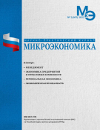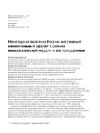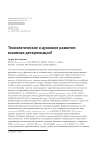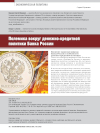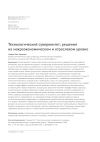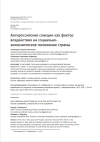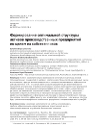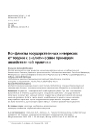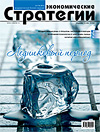Монетарная политика России: негативный накопительный эффект в рамках неоклассической модели и его преодоление
DOI: 10.33917/mic-2.103.2022.5-38
Денежно-кредитная политика является важнейшим инструментом политики экономического роста, но влияние любого инструмента с течением времени может ослабляться или усиливаться. Это состояние обозначим как накопительный эффект денежно-кредитной политики. Целью исследования выступает определение накопительного эффекта денежно-кредитной политики, с выявлением результативности ее мер в обеспечении роста российской экономики. Методологию исследования составляет монетарная теория, структурный анализ денежной массы, принцип «цели-инструменты» экономической политики и корреляционно-регрессионный анализ, позволяющие выявить наличие накопительного эффекта денежно-кредитной политики, определить ее влияние на релевантные макроэкономические цели: рост ВВП и инфляцию.
Результат исследования состоит в применении введенных показателей чувствительности целей макрополитики к инструментам денежно-кредитной политики, представляющих картину ослабления влияния денежно-кредитной политики на рост российской экономики. Увеличивающаяся монетизация сопровождалась, в частности, снижением темпа роста российской экономики, развертыванием рецессии, последствия которой сказываются на динамике экономического развития, сохраняя жесткий вариант денежно-кредитной политики – при повышении ключевой процентной ставки. Структурный анализ денежной массы по агрегату М2 позволил выявить те компоненты, которые при увеличении тормозят рост и снижают инфляцию, а также определить тесноту связи процентной ставки с изменяющимися компонентами денежной массы. Оценка накопительного эффекта денежно-кредитной политики по двум целям макроэкономического развития – росту и инфляции, и двум инструментам монетарной политики – денежной массе М2 и ключевой процентной ставке, подтвердила наличие отрицательного накопительного эффекта политики для цели роста и положительный накопительный эффект – по уровню инфляции. Для двух целей сразу положительный накопительный эффект монетарной политики подтверждается только для периода 2016-2018 гг. на интервале 2001-2020 гг. Тем самым денежно-кредитная политика, во-первых, обеспечивала сдерживание инфляции вне связи с ростом, во-вторых, обеспечивала по разным целям различные накопительные эффекты – за счет разной чувствительности цели к инструментам. Перспектива исследования видится в создании некоего агрегированного показателя, который бы позволял учесть общее влияние на динамику всего набора мер денежно-кредитной политики, а не раздельно по целям и инструментам, как представлено в настоящем исследовании.
Источники:
1. Глазьев С. Ю. Рывок в будущее. Россия в новых технологическом и мирохозяйственном укладах. М.: Книжный мир, 2018. 768 с.
2. Глазьев С.Ю. Уроки очередной российской революции: крах либеральной утопии и шанс на «экономическое чудо». М.: Издательский дом «Экономическая газета», 2011. 576 с.
3. Глазьев С. Ю. Теория долгосрочного технико-экономического развития. М.: Владар, 1993. 310 с.
4. Сухарев О.С. Экономический рост и финансовые институты: влияние на макро и микроуровне. Финансовый журнал. 2017. № 2. С. 163-177.
5. Сухарев О.С. Изменение доктрины денежно-кредитной и бюджетной политики в условиях рецессии. Федерализм. 2015. № 1. С.93-110.
6. Сухарев О.С. Денежно-кредитная политика ремонетизации экономики: теоретический аспект. Финансовая аналитика: проблемы и решения. 2014. № 19(205). С. 13-21.
7. Abbritti M., Aguilera-Bravo A., Trani T. (2021). Long-term business relationships, bargaining and monetary policy. Economic Modelling, Volume 101, August 2021, 105551. https://doi.org/10.1016/j.econmod.2021.105551
8. Alpanda S., Granziera E., Zubairy S. (2021). State dependence of monetary policy across business, credit and interest rate cycles. European Economic Review, Available online 15 October 2021, 103936. https://doi.org/10.1016/j.euroecorev.2021.103936
9. Altavilla C., Canova F., Ciccarelli M. (2020). Mending the broken link: Heterogeneous bank lending rates and monetary policy pass-through. Journal of Monetary Economics, Volume 110, April 2020, pp. 81-98. https://doi.org/10.1016/j.jmoneco.2019.01.001
10. Azad N. F., Serletis A., Xu L. (2021). Covid-19 and monetary–fiscal policy interactions in Canada. The Quarterly Review of Economics and Finance, Volume 81, August 2021, pp. 376-384. https://doi.org/10.1016/j.qref.2021.06.009
11. Azariadis C., Bullard J., Singh A., Suda J. (2019). Incomplete credit markets and monetary policy. Journal of Economic Dynamics and Control, Volume 103, June 2019, pp. 83-101. https://doi.org/10.1016/j.jedc.2019.03.005
12. Bianco T. (2021). Monetary policy and credit flows. Journal of Macroeconomics, Volume 70, December 2021, 103362. https://doi.org/10.1016/j.jmacro.2021.103362
13. Boucekkine R., Laksaci M., Touati-Tliba M. (2021). Long-run stability of money demand and monetary policy: The case of Algeria. The Journal of Economic Asymmetries, Volume 24, November 2021, e00217 https://doi.org/10.1016/j.jeca.2021.e00217
14. Breitenlechner M., Scharler J. (2021). Monetary policy announcements and bank lending: Do banks’ refinancing markets matter? Economic Modelling, Volume 102, September 2021, 105559 https://doi.org/10.1016/j.econmod.2021.105559
15. Bua C., Rogers J., Wu W. (2021). A unified measure of Fed monetary policy shocks. Journal of Monetary Economics, Volume 118, March 2021, pp. 331-349. https://doi.org/10.1016/j.jmoneco.2020.11.002
16. Cai Y. (2021). Expansionary monetary policy and credit allocation: Evidence from China. China Economic Review, Volume 66, April 2021, 101595 https://doi.org/10.1016/j.chieco.2021.101595
17. Caraiani P., Dutescu A., Hoinaru R., Stănilă O.G. (2020). Production network structure and the impact of the monetary policy shocks: Evidence from the OECD. Economics Letters, Volume 193, August 2020, 109271 https://doi.org/10.1016/j.econlet.2020.109271
18. Chang Y., Maih J., Tan F. (2021). Origins of monetary policy shifts: A New approach to regime switching in DSGE models. Journal of Economic Dynamics and Control, Volume 133, December 2021, 104235 https://doi.org/10.1016/j.jedc.2021.104235
19. Chen Z, Valcarcel V.J. (2021) Monetary transmission in money markets: The not-so-elusive missing piece of the puzzle. Journal of Economic Dynamics and Control, Volume 131, October, 104214 https://doi.org/10.1016/j.jedc.2021.104214
20. Chiu J., Molico M. (2021). Short-run dynamics in a search-theoretic model of monetary exchange. Review of Economic Dynamics, Volume 42, October 2021, pp. 133-155. https://doi.org/10.1016/j.red.2020.10.009
21. Claus E., Nguyen V. H. (2020). Monetary policy shocks from the consumer perspective. Journal of Monetary Economics, Volume 114, October 2020, pp. 159-173. https://doi.org/10.1016/j.jmoneco.2019.03.012
22. Cobham D., Song M. (2021). Transitions between monetary policy frameworks and their effects on economic performance. Economic Modelling, Volume 95, February 2021, pp. 311-329. https://doi.org/10.1016/j.econmod.2020.02.049
23. Cobham D., Song M. (2020). How do countries choose their monetary policy frameworks? Journal of Policy Modeling, Volume 42, Issue 6, November–December 2020, pp. 1187-1207. https://doi.org/10.1016/j.jpolmod.2020.04.008
24. Coenen G., Montes-Galdón C., Schmidt S. (2021). Macroeconomic stabilisation and monetary policy effectiveness in a low-interest-rate environment. Journal of Economic Dynamics and Control, Available online 8 August 2021, 104205 https://doi.org/10.1016/j.jedc.2021.104205
25. Costa Junior C. J., Garcia-Cintado A.C., Junior K. M. (2021). Macroeconomic policies and the pandemic-driven recession. International Review of Economics & Finance, Volume 72, March 2021, pp. 438-465. https://doi.org/10.1016/j.iref.2020.12.010
26. Dang V. D., Dang V. C. (2020). The conditioning role of performance on the bank risk-taking channel of monetary policy: Evidence from a multiple-tool regime. Research in International Business and Finance, Volume 54, December 2020, 101301 https://doi.org/10.1016/j.ribaf.2020.101301
27. Dang V. D., Huynh J. (2022). Bank funding, market power, and the bank liquidity creation channel of monetary policy. Research in International Business and Finance, Volume 59, January 2022, 101531 https://doi.org/10.1016/j.ribaf.2021.101531
28. Dées S., Galesi A. (2021). The Global Financial Cycle and US monetary policy in an interconnected world. Journal of International Money and Finance, Volume 115, July 2021, 102395 https://doi.org/10.1016/j.jimonfin.2021.102395
29. De Grauwe P., Ji Y. (2020). Structural reforms, animal spirits, and monetary policies. European Economic Review, Volume 124, May 2020, 103395 https://doi.org/10.1016/j.euroecorev.2020.103395
30. De La Peña R. (2021). Should monetary policy lean against the wind in a small-open economy? Revisiting the Tinbergen rule. Latin American Journal of Central Banking, Volume 2, Issue 1, March 2021, 100026 https://doi.org/10.1016/j.latcb.2021.100026
31. Dhital S., Gomis-Porqueras P., Haslag J. H. (2021). Monetary and fiscal policy interactions in a frictional model of fiat money, nominal public debt and banking. European Economic Review, Volume 139, October 2021, 103861 https://doi.org/10.1016/j.euroecorev.2021.103861
32. El-Shagi M., Turcu C. (2021). Monetary, financial and fiscal fragility in 2020s. Journal of International Money and Finance, Volume 117, October 2021, 102439 https://doi.org/10.1016/j.jimonfin.2021.102439
33. Eo Y., Kang K. H. (2020). The effects of conventional and unconventional monetary policy on forecasting the yield curve. Journal of Economic Dynamics and Control, Volume 111, February 2020, 103812 https://doi.org/10.1016/j.jedc.2019.103812
34. Ferrari M., Kearns J., Schrimpf A. (2021). Monetary policy’s rising FX impact in the era of ultra-low rates. Journal of Banking & Finance, Volume 129, August 2021, 106142 https://doi.org/10.1016/j.jbankfin.2021.106142
35. Feyen E., Alonso Gispert T., Kliatskova T., Mare D.S. (2021). Financial Sector Policy Response to COVID-19 in Emerging Markets and Developing Economies. Journal of Banking & Finance, Available online 21 May 2021, 106184 https://doi.org/10.1016/j.jbankfin.2021.106184
36. Filiani P. (2021). Optimal monetary–fiscal policy in the euro area liquidity crisis. Journal of Macroeconomics, Volume 70, December 2021, 103364 https://doi.org/10.1016/j.jmacro.2021.103364
37. Fontana G., Passarella M.V. (2020). Unconventional monetary policies from conventional theories: Modern lessons for central bankers. Journal of Policy Modeling, Volume 42, Issue 3, May–June 2020, pp. 503-519. https://doi.org/10.1016/j.jpolmod.2020.01.001
38. Furlanetto F., Gelain P., Sanjani M. T. (2021). Output gap, monetary policy trade-offs, and financial frictions. Review of Economic Dynamics, Volume 41, July 2021, pp. 52-70. https://doi.org/10.1016/j.red.2020.07.004
39. Garga V., Singh S.R. (2021). Output hysteresis and optimal monetary policy. Journal of Monetary Economics, Volume 117, January 2021, pp. 871-886. https://doi.org/10.1016/j.jmoneco.2020.06.005
40. Ghassibe M. (2021). Monetary policy and production networks: an empirical investigation. Journal of Monetary Economics, Volume 119, April 2021, pp. 21-39. https://doi.org/10.1016/j.jmoneco.2021.02.002
41. Glocker C., Piribauer P. (2021). Digitalization, retail trade and monetary policy. Journal of International Money and Finance, Volume 112, April 2021, 102340 https://doi.org/10.1016/j.jimonfin.2020.102340
42. Harding M., Klein M. (2021). Monetary policy and household net worth. Review of Economic Dynamics, Available online 4 March 2021 https://doi.org/10.1016/j.red.2021.02.013
43. Holm-Hadullaa F., Thürwächter C. (2021). Heterogeneity in corporate debt structures and the transmission of monetary policy. European Economic Review, Volume 136, July 2021, 103743 https://doi.org/10.1016/j.euroecorev.2021.103743
44. Hulsewig O., Steinbach A. (2021). Monetary financing and fiscal discipline. International Review of Law and Economics, Volume 68, December 2021, 106004 https://doi.org/10.1016/j.irle.2021.106004
45. Iddrisu A.-A., Alagidede I. P. (2020). Revisiting interest rate and lending channels of monetary policy transmission in the light of theoretical prescriptions. Central Bank Review, Volume 20, Issue 4, December 2020, pp. 183-192. https://doi.org/10.1016/j.cbrev.2020.09.002
46. Jin H., Xiong C. (2021). Fiscal stress and monetary policy stance in oil-exporting countries. Journal of International Money and Finance, Volume 111, March 2021, 102302 https://doi.org/10.1016/j.jimonfin.2020.102302
47. Kaminska I., Mumtaz H., Šustek R. (2021). Monetary policy surprises and their transmission through term premia and expected interest rates. Journal of Monetary Economics, Available online 30 July 2021 https://doi.org/10.1016/j.jmoneco.2021.07.009
48. Kim M. (2021). Transmission of U.S. monetary policy to commodity exporters and importers. Review of Economic Dynamics, Available online 10 February 2021 https://doi.org/10.1016/j.red.2021.02.005
49. Lang S., Schadner W. (2021). The trilemma of expansionary monetary policy in the Euro area during the COVID-19 crisis. Finance Research Letters, Volume 42, October 2021, 102048 https://doi.org/10.1016/j.frl.2021.102048
50. Lastauskas P., Stakenas J. (2020). Labor market reforms and the monetary policy environment. European Economic Review, Volume 128, September 2020, 103509 https://doi.org/10.1016/j.euroecorev.2020.103509
51. Laureys L., Meeks R., Wanengkirtyo B. (2021). Optimal simple objectives for monetary policy when banks matter. European Economic Review, Volume 135, June 2021, 103719 https://doi.org/10.1016/j.euroecorev.2021.103719
52. Le V. P. M., Meenagh D., Minford P. (2021). State-dependent pricing turns money into a two-edged sword: A new role for monetary policy. Journal of International Money and Finance, Volume 119, December 2021, 102496 https://doi.org/10.1016/j.jimonfin.2021.102496
53. Lee K.-S., Werner R. A. (2018). Reconsidering Monetary Policy: An Empirical Examination of the Relationship Between Interest Rates and Nominal GDP Growth in the U.S., U.K., Germany and Japan. Ecological Economics, Volume 146, April 2018, pp. 26-34. https://doi.org/10.1016/j.ecolecon.2017.08.013
54. Li B., Pei P., Tan F. (2021). Financial distress and fiscal inflation. Journal of Macroeconomics, Volume 70, December 2021, 103353 https://doi.org/10.1016/j.jmacro.2021.103353
55. Li H., Ni J., Xu Y., Zhan M. (2021). Monetary policy and its transmission channels: Evidence from China. Pacific-Basin Finance Journal, Volume 68, September 2021, 101621 https://doi.org/10.1016/j.pacfin.2021.101621
56. Li X.-L., Yan J., Wei X. (2021). Dynamic connectedness among monetary policy cycle, financial cycle and business cycle in China. Economic Analysis and Policy, Volume 69, March 2021, pp. 640-652. https://doi.org/10.1016/j.eap.2021.01.014
57. Liu X. (2021). On fiscal and monetary policy-induced macroeconomic volatility dynamics. Journal of Economic Dynamics and Control, Volume 127, June 2021, 104123 https://doi.org/10.1016/j.jedc.2021.104123
58. Mandel A., Veetil V.P. (2021). Monetary dynamics in a network economy. Journal of Economic Dynamics and Control, Volume 125, April 2021, 104084 https://doi.org/10.1016/j.jedc.2021.104084
59. Mauersberger F. (2021). Monetary policy rules in a non-rational world: A macroeconomic experiment. Journal of Economic Theory, Volume 197, October 2021, 105203 https://doi.org/10.1016/j.jet.2021.105203
60. Min F., Wen F.,Wang X. (2021). Measuring the effects of monetary and fiscal policy shocks on domestic investment in China. International Review of Economics and Finance, Available online 11 October 2021 https://doi.org/10.1016/j.iref.2021.10.010
61. Mohseni M.R., Cao J. (2020). Monetary policy and financial economic growth. The Journal of Economic Asymmetries, Volume 22, November 2020, e00169 https://doi.org/10.1016/j.jeca.2020.e00169
62. Moreira R. R., Monte E.Z. (2020). Reviewing monetary policy inertia and its effects: The fractional integration approach for an emerging economy. The Quarterly Review of Economics and Finance, Volume 78, November 2020, pp. 34-41. https://doi.org/10.1016/j.qref.2020.05.006
63. Mumtaz H., Theodoridis K. (2020). Dynamic effects of monetary policy shocks on macroeconomic volatility. Journal of Monetary Economics, Volume 114, October 2020, pp. 262-282. https://doi.org/10.1016/j.jmoneco.2019.03.011
64. Murgia L.M. (2020). The effect of monetary policy shocks on macroeconomic variables: Evidence from the Eurozone. Economics Letters, Volume 186, January 2020, 108803 https://doi.org/10.1016/j.econlet.2019.108803
65. Pasten E., Schoenle R., Weber M. (2020). The propagation of monetary policy shocks in a heterogeneous production economy. Journal of Monetary Economics, Volume 116, December 2020, pp. 1-22. https://doi.org/10.1016/j.jmoneco.2019.10.001
66. Pietrunti M., Signoretti F.M. (2020). Unconventional monetary policy and household debt: The role of cash-flow effects. Journal of Macroeconomics, Volume 64, June 2020, 103201 https://doi.org/10.1016/j.jmacro.2020.103201
67. Poloz S.S. (2021). Technological progress and monetary policy: Managing the fourth industrial revolution. Journal of International Money and Finance, Volume 114, June 2021, 102373 https://doi.org/10.1016/j.jimonfin.2021.102373
68. Razmi S. F., Moghadam M. H., Behname M. (2021). Time-varying effects of monetary policy on Iranian renewable energy generation. Renewable Energy, Volume 177, November 2021, pp. 1161-1169. https://doi.org/10.1016/j.renene.2021.06.020
69. Roevekamp I. (2021). The impact of US monetary policy on managed exchange rates and currency peg regimes. Journal of International Money and Finance, Volume 110, February 2021, 102266 https://doi.org/10.1016/j.jimonfin.2020.102266
70. Rubio M. (2020). Monetary policy, credit markets, and banks: A DSGE perspective. Economics Letters, Volume 195, October 2020, 109481 https://doi.org/10.1016/j.econlet.2020.109481
71. Sawyer M., Veronese Passarella M. (2021). A Comprehensive Comparison of Fiscal and Monetary Policies: A Comparative Dynamics Approach. Structural Change and Economic Dynamics, Volume 59, December 2021, pp. 384-404. https://doi.org/10.1016/j.strueco.2021.08.009
72. Sequeira J.M. (2021а). Monetary policy surprises, stock returns, and financial and liquidity constraints, in an exchange rate monetary policy system. The Quarterly Review of Economics and Finance, Volume 81, August 2021, pp. 226-236. https://doi.org/10.1016/j.qref.2021.06.005
73. Sequeira T.N. (2021b). Inflation, economic growth and education expenditure. Economic Modelling, Volume 99, June 2021, 105475 https://doi.org/10.1016/j.econmod.2021.02.016
74. Serletis A., Xu L. (2020). Functional monetary aggregates, monetary policy, and business cycles. Journal of Economic Dynamics and Control, Volume 121, December 2020,103994 https://doi.org/10.1016/j.jedc.2020.103994
75. Siklos P.L. (2021). The macroeconomic response to real and financial factors, commodity prices, and monetary policy: International evidence. Economic Systems, Volume 45, Issue 1, March 2021, 100850 https://doi.org/10.1016/j.ecosys.2020.100850
76. Tinbergen J. (1952) On the Theory of Economic Policy. Contributions to economic analysis, I. Amsterdam, North Holland Publishing Company, 78 p.
77. Wang J., Wu J. (2021). Is capital flow management effective? Evidence based on U.S. monetary policy shocks. Journal of International Money and Finance, Volume 118, November 2021, 102451 https://doi.org/10.1016/j.jimonfin.2021.102451
78. Wu W. (2021). Sales of durable goods and the real effects of monetary policy. Review of Economic Dynamics, Available online 28 January 2021 https://doi.org/10.1016/j.red.2021.01.002


